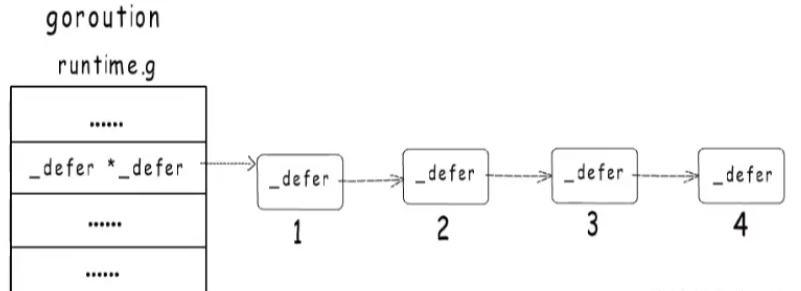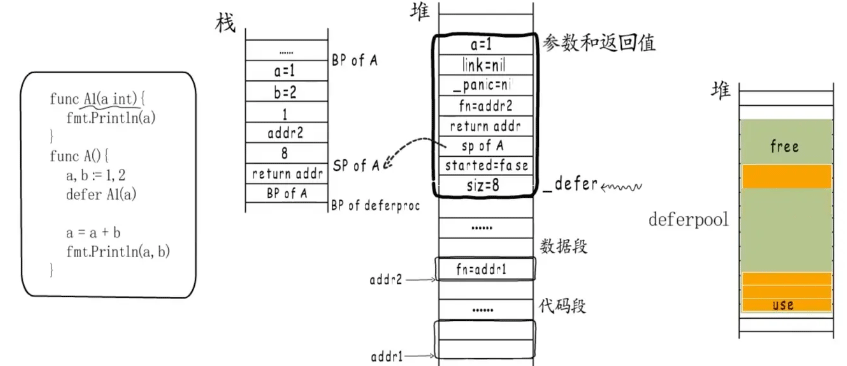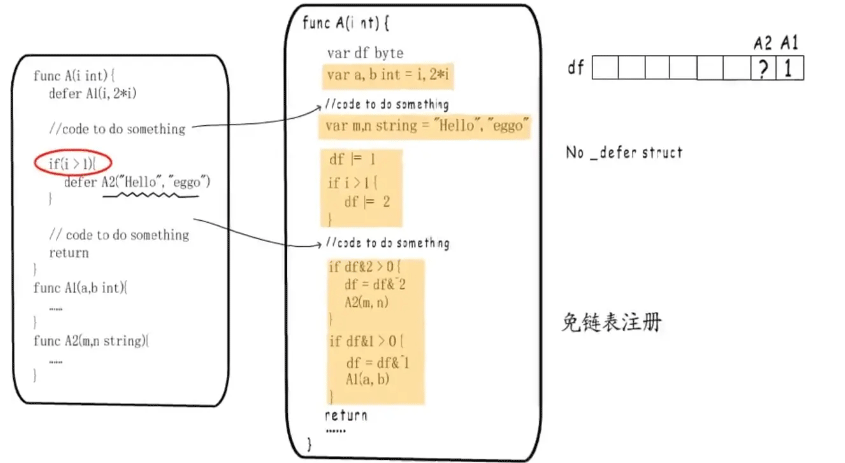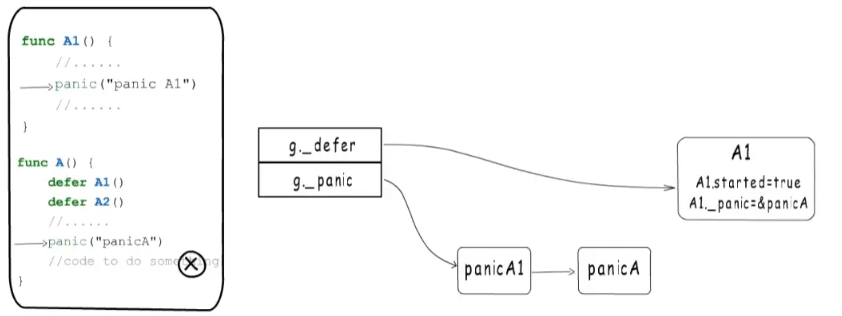Golang的关键字defer的使用方法
怎么入门Golang编程?需要学习哪些知识点?这是新手们刚接触编程时常见的问题;下面golang学习网就来给大家整理分享一些知识点,希望能够给初学者一些帮助。本篇文章就来介绍《Golang的关键字defer的使用方法》,涉及到defer、关键字,有需要的可以收藏一下
核心思想
在defer出现的地方插入了指令CALL runtime.deferproc,在函数返回的地方插入了CALL runtime.deferreturn。goroutine的控制结构中,有一张表记录defer,调用runtime.deferproc时会将需要defer的表达式记录在表中,而在调用runtime.deferreturn的时候,则会依次从defer表中“出栈”并执行
如果有多个defer,调用顺序类似栈,越后面的defer表达式越先被调用
defer链
defer信息会注册到链表,当前执行的 goroutine 持有这个链表的头指针,每个 goroutine 都有一个对应的结构体struct G,其中有一个字段指向这个defer链表头
type g struct {
// Stack parameters.
// stack describes the actual stack memory: [stack.lo, stack.hi).
// stackguard0 is the stack pointer compared in the Go stack growth prologue.
// It is stack.lo+StackGuard normally, but can be StackPreempt to trigger a preemption.
// stackguard1 is the stack pointer compared in the C stack growth prologue.
// It is stack.lo+StackGuard on g0 and gsignal stacks.
// It is ~0 on other goroutine stacks, to trigger a call to morestackc (and crash).
stack stack // offset known to runtime/cgo
stackguard0 uintptr // offset known to liblink
stackguard1 uintptr // offset known to liblink
_panic *_panic // innermost panic - offset known to liblink
// _defer 这个字段指向defer链表头
_defer *_defer // innermost defer
...
}
新注册的defer会添加到链表头,所以感觉像是栈那样先进后出的调用:

源码分析
deferproc一共有两个参数,第一个是参数和返回值的大小,第二个是指向funcval的指针
// Create a new deferred function fn with siz bytes of arguments.
// The compiler turns a defer statement into a call to this.
//go:nosplit
func deferproc(siz int32, fn *funcval) { // arguments of fn follow fn
// 获取当前goroutine
gp := getg()
if gp.m.curg != gp {
// go code on the system stack can't defer
throw("defer on system stack")
}
// the arguments of fn are in a perilous state. The stack map
// for deferproc does not describe them. So we can't let garbage
// collection or stack copying trigger until we've copied them out
// to somewhere safe. The memmove below does that.
// Until the copy completes, we can only call nosplit routines.
// 获取调用者指针
sp := getcallersp()
// 通过偏移获得参数
argp := uintptr(unsafe.Pointer(&fn)) + unsafe.Sizeof(fn)
callerpc := getcallerpc()
// 创建defer结构体
d := newdefer(siz)
if d._panic != nil {
throw("deferproc: d.panic != nil after newdefer")
}
// 初始化
d.link = gp._defer
gp._defer = d
d.fn = fn
d.pc = callerpc
d.sp = sp
switch siz {
case 0:
// Do nothing.
case sys.PtrSize:
*(*uintptr)(deferArgs(d)) = *(*uintptr)(unsafe.Pointer(argp))
default:
memmove(deferArgs(d), unsafe.Pointer(argp), uintptr(siz))
}
// deferproc returns 0 normally.
// a deferred func that stops a panic
// makes the deferproc return 1.
// the code the compiler generates always
// checks the return value and jumps to the
// end of the function if deferproc returns != 0.
return0()
// No code can go here - the C return register has
// been set and must not be clobbered.
}
// 以下是_defer结构体
// A _defer holds an entry on the list of deferred calls.
// If you add a field here, add code to clear it in freedefer and deferProcStack
// This struct must match the code in cmd/compile/internal/gc/reflect.go:deferstruct
// and cmd/compile/internal/gc/ssa.go:(*state).call.
// Some defers will be allocated on the stack and some on the heap.
// All defers are logically part of the stack, so write barriers to
// initialize them are not required. All defers must be manually scanned,
// and for heap defers, marked.
type _defer struct {
// siz 记录defer的参数和返回值共占多少字节
// 会直接分配在_defer后面,在注册时保存参数,在执行完成时拷贝到调用者参数和返回值空间
siz int32 // includes both arguments and results
// started 标记是否已经执行
started bool
// heap go1.13优化,标识是否为堆分配
heap bool
// openDefer indicates that this _defer is for a frame with open-coded
// defers. We have only one defer record for the entire frame (which may
// currently have 0, 1, or more defers active).
// openDefer 是否是open defer,通过这些信息可以找到未注册到链表的defer函数
openDefer bool
// sp 记录调用者栈指针,可以通过它判断自己注册的defer是否已经执行完了
sp uintptr // sp at time of defer
// pc deferproc的返回地址
pc uintptr // pc at time of defer
// fn 要注册的funcval
fn *funcval // can be nil for open-coded defers
// _panic 指向当前的panic,表示这个defer是由这个panic触发的
_panic *_panic // panic that is running defer
// link 链到前一个注册的defer结构体
link *_defer
// If openDefer is true, the fields below record values about the stack
// frame and associated function that has the open-coded defer(s). sp
// above will be the sp for the frame, and pc will be address of the
// deferreturn call in the function.
// 通过这些信息可以找到未注册到链表的defer函数
fd unsafe.Pointer // funcdata for the function associated with the frame
varp uintptr // value of varp for the stack frame
// framepc is the current pc associated with the stack frame. Together,
// with sp above (which is the sp associated with the stack frame),
// framepc/sp can be used as pc/sp pair to continue a stack trace via
// gentraceback().
framepc uintptr
}
defer将参数注册的时候拷贝到堆上,执行时再(将参数和返回值)拷贝回栈上
go会分配不同规格的_defer pool,执行时从空闲_defer中取一个出来用,没有合适的再进行堆分配。用完以后再放回空闲_defer pool。以避免频繁的堆分配和回收

优化
go1.12中defer存在的问题:
- defer信息主要存储在堆上,要在堆和栈上来回拷贝返回值和参数很慢
- defer结构体通过链表链起来,而链表的操作也很慢
go1.13中defer的优化:
- 减少了defer信息的堆分配。再通过deferprocStack将整个defer注册到defer链表中
- 将一般情况的defer信息存储在函数栈帧的局部变量区域
- 显示循环或者是隐式循环的defer还是需要用到go1.12中defer信息的堆分配
- 官方给出的性能提升是30%
go1.14中defer的优化:
- 在编译阶段插入代码,把defer函数的执行逻辑展开在所属函数内,避免创建defer结构体,而且不需要注册到defer链表。称为 open coded defer
- 与1.13一样不适用于循环中的defer
- 性能几乎提升了一个数量级
- open coded defer 中发生panic 或 调用runtime.Goexit(),后面未注册到的defer函数无法执行到,需要栈扫描。defer结构体中就多添加了一些字段,借助这些字段可以找到未注册到链表中的defer函数
结果就是defer变快了,但是panic变慢了
defer添加了局部变量去判断是否需要执行,需要执行的话就将标识df对应的位上或一下,如果是有条件的defer,需要根据具体条件去或df

deferprocStack
// deferprocStack queues a new deferred function with a defer record on the stack.
// The defer record must have its siz and fn fields initialized.
// All other fields can contain junk.
// The defer record must be immediately followed in memory by
// the arguments of the defer.
// Nosplit because the arguments on the stack won't be scanned
// until the defer record is spliced into the gp._defer list.
//go:nosplit
func deferprocStack(d *_defer) {
// 获得当前 goroutine
gp := getg()
if gp.m.curg != gp {
// go code on the system stack can't defer
throw("defer on system stack")
}
// siz and fn are already set.
// The other fields are junk on entry to deferprocStack and
// are initialized here.
// 初始化 _defer 信息
d.started = false
d.heap = false
d.openDefer = false
d.sp = getcallersp()
d.pc = getcallerpc()
d.framepc = 0
d.varp = 0
// The lines below implement:
// d.panic = nil
// d.fd = nil
// d.link = gp._defer
// gp._defer = d
// But without write barriers. The first three are writes to
// the stack so they don't need a write barrier, and furthermore
// are to uninitialized memory, so they must not use a write barrier.
// The fourth write does not require a write barrier because we
// explicitly mark all the defer structures, so we don't need to
// keep track of pointers to them with a write barrier.
*(*uintptr)(unsafe.Pointer(&d._panic)) = 0
*(*uintptr)(unsafe.Pointer(&d.fd)) = 0
*(*uintptr)(unsafe.Pointer(&d.link)) = uintptr(unsafe.Pointer(gp._defer))
*(*uintptr)(unsafe.Pointer(&gp._defer)) = uintptr(unsafe.Pointer(d))
return0()
// No code can go here - the C return register has
// been set and must not be clobbered.
}
今天关于《Golang的关键字defer的使用方法》的内容就介绍到这里了,是不是学起来一目了然!想要了解更多关于golang的内容请关注golang学习网公众号!
 Golang中panic与recover的区别
Golang中panic与recover的区别
- 上一篇
- Golang中panic与recover的区别

- 下一篇
- 利用go语言实现Git 重命名远程分支
-

- Golang · Go教程 | 4小时前 | 格式化输出 printf fmt库 格式化动词 Stringer接口
- Golangfmt库用法与格式化技巧解析
- 140浏览 收藏
-

- Golang · Go教程 | 4小时前 |
- Golang配置Protobuf安装教程
- 147浏览 收藏
-

- Golang · Go教程 | 4小时前 |
- Golang中介者模式实现与通信解耦技巧
- 378浏览 收藏
-

- Golang · Go教程 | 4小时前 |
- Golang多协程通信技巧分享
- 255浏览 收藏
-

- Golang · Go教程 | 5小时前 |
- Golang如何判断变量类型?
- 393浏览 收藏
-

- Golang · Go教程 | 5小时前 |
- Golang云原生微服务实战教程
- 310浏览 收藏
-

- Golang · Go教程 | 5小时前 |
- Golang迭代器与懒加载结合应用
- 110浏览 收藏
-

- Golang · Go教程 | 6小时前 | 性能优化 并发安全 Golangslicemap 预设容量 指针拷贝
- Golangslicemap优化技巧分享
- 412浏览 收藏
-

- Golang · Go教程 | 6小时前 |
- Golang代理模式与访问控制实现解析
- 423浏览 收藏
-

- Golang · Go教程 | 6小时前 |
- Golang事件管理模块实现教程
- 274浏览 收藏
-

- 前端进阶之JavaScript设计模式
- 设计模式是开发人员在软件开发过程中面临一般问题时的解决方案,代表了最佳的实践。本课程的主打内容包括JS常见设计模式以及具体应用场景,打造一站式知识长龙服务,适合有JS基础的同学学习。
- 543次学习
-

- GO语言核心编程课程
- 本课程采用真实案例,全面具体可落地,从理论到实践,一步一步将GO核心编程技术、编程思想、底层实现融会贯通,使学习者贴近时代脉搏,做IT互联网时代的弄潮儿。
- 516次学习
-

- 简单聊聊mysql8与网络通信
- 如有问题加微信:Le-studyg;在课程中,我们将首先介绍MySQL8的新特性,包括性能优化、安全增强、新数据类型等,帮助学生快速熟悉MySQL8的最新功能。接着,我们将深入解析MySQL的网络通信机制,包括协议、连接管理、数据传输等,让
- 500次学习
-

- JavaScript正则表达式基础与实战
- 在任何一门编程语言中,正则表达式,都是一项重要的知识,它提供了高效的字符串匹配与捕获机制,可以极大的简化程序设计。
- 487次学习
-

- 从零制作响应式网站—Grid布局
- 本系列教程将展示从零制作一个假想的网络科技公司官网,分为导航,轮播,关于我们,成功案例,服务流程,团队介绍,数据部分,公司动态,底部信息等内容区块。网站整体采用CSSGrid布局,支持响应式,有流畅过渡和展现动画。
- 485次学习
-

- ChatExcel酷表
- ChatExcel酷表是由北京大学团队打造的Excel聊天机器人,用自然语言操控表格,简化数据处理,告别繁琐操作,提升工作效率!适用于学生、上班族及政府人员。
- 3164次使用
-

- Any绘本
- 探索Any绘本(anypicturebook.com/zh),一款开源免费的AI绘本创作工具,基于Google Gemini与Flux AI模型,让您轻松创作个性化绘本。适用于家庭、教育、创作等多种场景,零门槛,高自由度,技术透明,本地可控。
- 3376次使用
-

- 可赞AI
- 可赞AI,AI驱动的办公可视化智能工具,助您轻松实现文本与可视化元素高效转化。无论是智能文档生成、多格式文本解析,还是一键生成专业图表、脑图、知识卡片,可赞AI都能让信息处理更清晰高效。覆盖数据汇报、会议纪要、内容营销等全场景,大幅提升办公效率,降低专业门槛,是您提升工作效率的得力助手。
- 3405次使用
-

- 星月写作
- 星月写作是国内首款聚焦中文网络小说创作的AI辅助工具,解决网文作者从构思到变现的全流程痛点。AI扫榜、专属模板、全链路适配,助力新人快速上手,资深作者效率倍增。
- 4509次使用
-

- MagicLight
- MagicLight.ai是全球首款叙事驱动型AI动画视频创作平台,专注于解决从故事想法到完整动画的全流程痛点。它通过自研AI模型,保障角色、风格、场景高度一致性,让零动画经验者也能高效产出专业级叙事内容。广泛适用于独立创作者、动画工作室、教育机构及企业营销,助您轻松实现创意落地与商业化。
- 3785次使用
-
- golang中的defer函数理解
- 2022-12-22 366浏览
-
- 一文搞懂Go语言中defer关键字的使用
- 2022-12-30 485浏览
-
- GolangDefer基础操作详解
- 2022-12-22 444浏览
-
- 详解golang中的闭包与defer
- 2023-01-07 461浏览
-
- Go iota关键字与枚举类型实现原理
- 2023-01-07 273浏览





